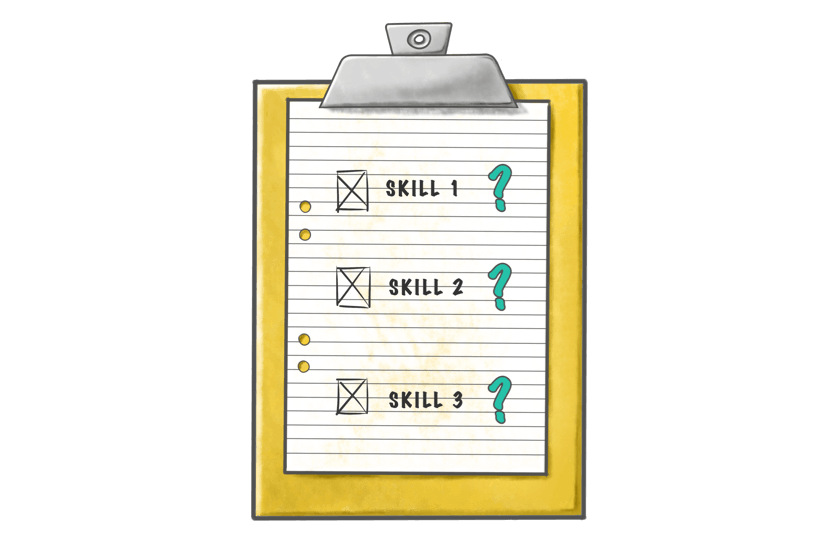
In the blink of an eye, it’s December again!
Surely you know the drill by now – Yarnoers are a pretty trendy bunch. We like to stay on top of anything and everything that goes on in the world of learning science, whether it’s new and emerging tech, shifts in workplace learning, or scientific research about how the brain works.
And we’re not here to gatekeep – no siree!
Quite the opposite, in fact. We’re here to share what we’ve learnt with the class.

It’s been a pretty hectic year in the workplace learning space. COVID-normal is the way of the world and we said goodbye to lockdowns and masks for good (hopefully). This meant re-learning the old ways of communicating in the office, as well as improving how we work in a hybrid environment.
We saw a widening of the skills gap, with the Australian Bureau of Statistics (ABS) reporting that 59% of applicants not having the relevant experience and skills. The ABS also identifies the rise of automation and AI as a huge influence on what skills will remain necessary in the future. Power skills – skills that cannot be automated – are the ones that will be more important.
And, of course we were faced with the reality of cybersecurity breaches.
Phew!
So, pull up a chair. Let’s break down some of these key trends of 2022.
Skills-based learning
Now this is a big one.
It’s a tough market out there. Employers are faced with labour shortages, inflation, high turnover rates – not to mention continuing Covid fallout! To even begin tackling these challenges, companies have to transition their learning content to be more skills-based, rather than role-based. Role-based learning looks at training an individual in how to do the work specifically outlined in their job description. Very helpful for the organisation in the moment, but not very future-proof.
Skills-based learning, on the other hand, looks to address skills gaps in the organisation so that a workforce can take on new tasks, and grow into new roles using the skills they have developed. For example, instead of learning how to use one specific software, skills-based learning might look at more general tech problem-solving, so if a user is unfamiliar with a new software, they have the foundational skills to figure it out on their own. Most companies are recognising internal upskilling as a key way to combat the skills gap, and keep their people satisfied at work.
Jamie Kohn, research director at Gartner HR, says companies will need to look into internal upskilling to compensate for the growing talent shortage. And there is a shortage.
New technologies are popping up every day, and as the way we work evolves, employees need to learn new skills to make sure they’re not left in the dust. Making sure your business is equipped to handle advances in the workplace, and has employees broadly skilled to cover any gaps, is pretty important.
But that’s not the only benefit of internal upskilling.
Offering development opportunities shows workers that their company cares about their future, and wants to see them succeed. A survey by GetApp saw nearly 80% of respondents say they were interested in engaging with upskilling or reskilling opportunities in their company. Development opportunities are directly linked with staff retention, morale-boosting, and productivity.

A major element of this internal upskilling is the development of soft skills, or as Josh Bersin prefers to reframe them – power skills – we’ve said it once, and we’ll say it again: power skills are so freaking important!!! Josh talks about how soft skills need to be seen as powerful in the workplace because “they are difficult to build, critical, and take extreme effort to obtain”. They are highly complex and are always developing.
Developing skills like communication, critical thinking, and emotional intelligence means that teams are well-equipped to tackle challenges and function as a team. According to UTS, there are severe skills gaps in change management and innovation – gaps that can be closed with investment in power skills training,
Power skills are more than a business skillset – they are people skills, and are necessary to nurture relationships both at work and outside of work. They are in high demand at the moment, both from employers and employees.
Employee-first learning experience
Something we’ve seen this year is a shift in the design and user experience of HR and learning tech.
Priorities are changing, and previously where software was designed for HR and learning managers, it’s now designed with employees in mind as the key users.
a) easy-to-use, and
b) embedded into the flow of work.
This has been a result of our changing working structure, enabling staff to work in the office, at home, or a combination of the two. Alongside this is the focus on creating learning that is mobile-first, allowing for equal learning opportunities across the team wherever they’re working from.

Learning tool architecture
As a result of the focus on employee-first learning experiences, the way learning is delivered is also shifting.
We’re seeing Learning Management Systems (LMS) fading into the background a bit. Instead of being the core learning platform for organisations, it’s becoming just part of the learning architecture, which is consistent with the move towards employee-centric experiences.
Budgets are being diverted away from the LMS towards Learning eXExperience Platform (LXP), content libraries, microlearning platforms, and video platforms.
Cybersecurity
We can’t talk about 2022 without talking about cybersecurity. If you’ve turned on the news recently (or, let’s face it, have checked your emails!) you’ve seen that prominent companies have really had their cybersecurity practices brought into focus.
Cybersecurity is a vital element of the workplace in the digital age, particularly given the rise of remote and hybrid work. If companies are holding data – and every company is! – they need to make sure their cybersecurity vigilance is in tip top shape.
According to the Australian Cyber Security Centre, there were over 76,000 cybercrime reports in the 2021-22 financial year, a 13 per cent increase from the previous year. The financial impacts of these crimes? Over $98 million in financial losses due to business email compromise. With increasing numbers of high-profile cases, the threat of cybercrime is only set to get worse.
The impact is that companies are reviewing their data protection protocols and how well their teams understand the risks of a serious breach.

There has also been discussion around whether we introduce GDPR (or something similar) in Australia. The GDPR is a European data protection law that basically gives individuals more control over their personal information. It's forced companies to rethink how they handle data, making “privacy by design” paramount.
At any rate, the Australian government has recently introduced new financial penalties for data breaches, so we are seeing upskillling in cyber security knowledge being prioritised across the country.
At Yarno, we take cyber security seriously. We value our customers’ faith in us and are committed to providing a secure and reliable experience.
Yarno’s commitment to cyber security
Our systems and processes are designed to keep the data we hold secure:
- Secure storage of data on Australian servers, hosted in the cloud with Amazon Web Services (AWS)
- Proactive detection of any vulnerabilities in our platform or security systems via third party penetration testing
- Industry-standard data encryption that helps defend against the impacts of cyber-attacks
Our internal controls aren’t the only way we protect your data. At Yarno, we routinely use learning campaigns to ensure all our employees are regularly trained in cyber security best practices. Because we understand that there’s always a risk of human error when it comes to cybercrime.
Wrap up
So, it’s been a pretty eventful year in the workplace learning space!
Employee-first tech is taking the helm, with new learning and HR software now targeting staff as the end-user. This means staff can integrate their learning with their everyday productivity tools and learn in the flow of work.
Alongside this, growing skills shortages mean companies need to invest in upskilling their teams.
So what’s going to happen next year?
The big areas of focus for companies will be investing in the development of power skills, and ensuring teams are up to date with cybersecurity training. We think staff can expect to see companies investing more and more in their professional development. A recent survey from the Australian Financial Review saw 70% of Australians say they prioritise learning opportunities over salary. Businesses with a sophisticated learning maturity and investment in their people will stand out.
Interested in taking your own cyber security training to the next level?
Yarno’s off-the-shelf Cyber Security Campaign is a great starting point. Our Content Team can also work with you to create a campaign tailored to your workplace systems and processes. Just contact Mark today on 0401 872 305.













































































































